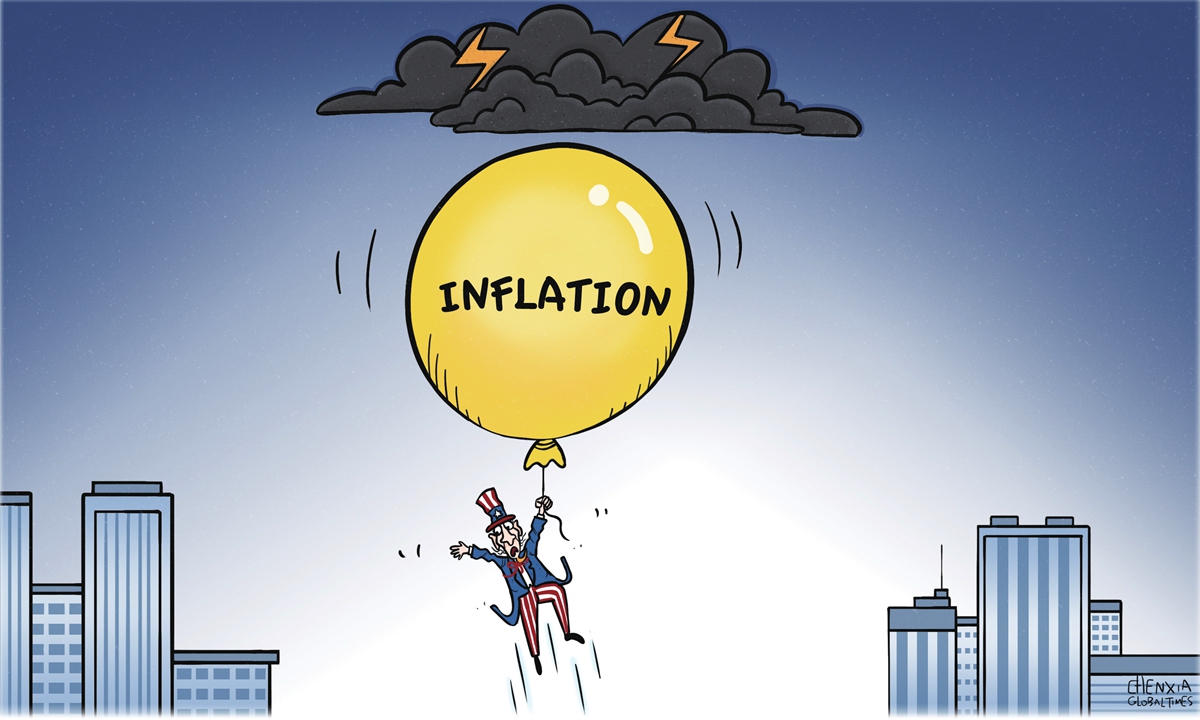Manufacturing retreat makes US economy more vulnerable to inflation

Illustration: Chen Xia/GT
I hope the White House economic advisors will go online and experience China's "6.18" shopping festival on June 18, which I believe will give them a thorough understanding of the causes of high inflation in the US.On this day 24 years ago, JD.com was founded in Beijing, and it has grown to become the largest B2C-based e-commerce company in China. Every year on this day, Chinese online shopping sites will launch a massive concentrated marketing campaign, often sharply driving up sales.
However, the advisors need not focus too much on sales, but should look more at the variety of small electronic products and household goods online during this period, and pay particular attention to the new ones launched this year and how many manufacturers are competing for the same product when it comes to innovation and price.
As you can imagine, the biggest headache for these US economic advisors right now is how to pull back the wild horse of unchecked inflation. Observing China's shopping festivals will make them realize that it will be difficult to solve this problem by relying only on temporary policy measures.
Experts have identified many reasons for current levels of inflation, such as the epidemic exacerbating tensions in the industrial and supply chain; soaring energy and food prices caused by the US and European sanctions against Russia; the artificially high prices created by increased US trade tariffs on China, and so on.
However, if you look at China's market supply, you will soon find that there is a large-scale, multi-level, all-round manufacturing industry to support China's consumer market. Although China also faces the impact of higher raw material and energy prices, the production of basic daily and consumer goods has a solid foundation that allows China to have the policy space to deal with inflation.
It is manufacturing that has created the difference in the structure between the Chinese and US economies, and thus the basis for US-China interdependence. Only in a more integrated and competitive manufacturing system is it possible to better absorb inflation.
Washington is actually aware of the problem, and since Obama, US leaders have continually raised the mantra of returning manufacturing to the US. In his first State of the Union address in March, Biden proposed a "better plan": to bring manufacturing back to the US to lower the cost of production, so that US consumers can enjoy the benefits. But the process is still in its infancy, and the outlook remains confusing.
Some economists now believe that the current inflation and concerns about the supply chain due to policies toward China and sanctions against Russia will help the US to accelerate its re-industrialization. This view ignores the difficulty of restructuring the US economy.
How many people are willing or dare to invest in industry in a country that prefers to make fast and easy money through capital markets?
Whether a country's manufacturing industry can rise depends in large part on whether there is a cultural spirit that helps the development or revival of manufacturing. Economists look at policies, restructuring, investment, innovation and profitability levels, but if there is a lack of work spirit to nurture manufacturing, there will not be enough young people willing to enter manufacturing, especially the middle and low-end manufacturing.
According to my experience of working in many countries around the world, the development or reconstruction of manufacturing is fundamentally a human problem. Why are many de-industrialized developed countries unable to revive their domestic manufacturing industries? It is because there are no more young people willing to stand before the machine. Education in these countries is no longer able to send more labor to the manufacturing industry.
Indeed, high-end manufacturing is still the strength of US manufacturing, as is innovation. But the high end needs to take root, and it's the low and mid-range that counts. The two are mutually reinforcing. The middle and low end is not a disadvantage. The high end can become a disadvantage if it is not effectively converted into a middle and low-end product.
Observing China's shopping festivals is a wonderful window into the interaction between the US and Chinese economies and trade. I hope they will realize that the industrial chain and supply chain are not at the mercy of their ideological standards.
Inflation is caused by the devaluation of a currency, usually due to the injection of more money into the economy. The current round of inflation in the US is no exception. The US has been able to keep inflation low in the past precisely because it has participated more proactively in the globalized division of labor and enjoyed the benefits of a more resilient supply chain with competitive Chinese manufacturing as part of this system.
And today the US is not only breaking this supply chain itself, but expects that this disruption will help rebuild the same system on US soil.
They are going against the trends, and instead of restructuring, they will destroy the basis on which their own economy is developed.
The author is a senior editor with People's Daily, and currently a senior fellow with the Chongyang Institute for Financial Studies at Renmin University of China. dinggang@globaltimes.com.cn. Follow him on Twitter @dinggangchina




